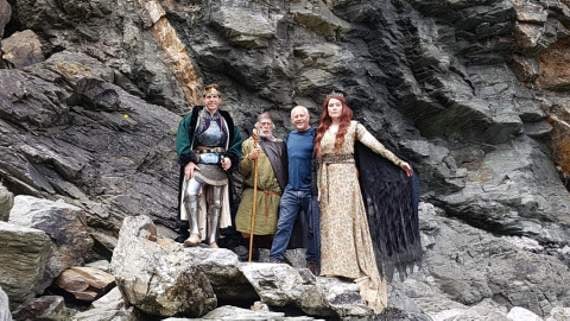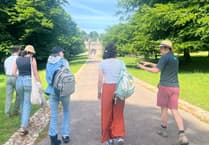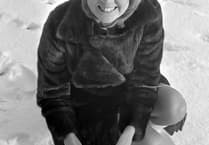AS we celebrate the re-opening of Tintagel Castle, following the construction of its brand new footbridge, evidence has been uncovered to suggest one of Britain’s most famous writers also enjoyed a trip to the rugged north Cornish setting.
Cornish historian and researcher, Barry West, has made some fascinating connections between Victorian phenomenon Charles Dickens and Tintagel Castle — which reopened to the public on Sunday, August 11 following the construction of a brand new footbridge to link the castle with the island.
Barry — who was previously featured in an article in the Post in February 2018, which detailed the inspiration behind one of Dickens’ most famous characters, Jacob Marley, being based on a Dr Miles Marley who is buried in St Endellion — is keen to make public Dickens’ fascination for the north Cornwall coastline, with a detailed account of the author’s visit to Tintagel in 1842.
On Saturday, October 22, 1842, Dickens wrote to Dr Southwood Smith expressing a wish to see ‘the very dreariest and most desolate portion’ of the Cornish coast.
He wrote: “My dear sir, I have an expedition afoot in which I think you can assist me. I want to see the very dreariest and desolate portion of the sea-coast of Cornwall; and start next Thursday, with a couple of friends, for St Michael’s Mount.
“Can you tell me of your own knowledge, or through the information of any Mining Sub-Commissioners, what is the next best bleak and barren part? And can you, furthermore, while I am in those regions, help me down a mine?”
Dr Southwood Smith replied: “I do not think you will find St Michael’s Mount particularly desolate, but it is nevertheless a very remarkable and interesting place. The coast about Land’s End, I am told, is incomparably more dreary and presents a fine specimen of wrecken scenery. But the place above all others for dreariness is Tintagel (King Arthur’s) castle, near Camelford. There shall you see nothing but bleak looking rocks and an everlastingly boisterous sea, both in much the same state as when good King Arthur reigned.”
Dr Smith also goes on to advise Dickens to visit Dr Charles Barham, a local physician at the time, ‘thoroughly acquainted with every nook in Cornwall and known to every mine’.
He added: “But pray do not forget that a Cornish mine is quite different from a coal-mine: while much less disagreeable to the senses, far more fatal in its effects upon the men and boys (they have no women).”
On Thursday, October 27, Dickens left for Cornwall with two artists and his biographer, Forster, Maclise and Stanfield, arriving in Exeter by train on Saturday, October 29 to stay at the New London Inn. Between October 30 and November 3 Dickens visited his father in Alphington, then set off to Plymouth, Land’s End and Tintagel.
Barry has found that the Royal Albert Bridge was not completed until 1859, making it seem very likely that Dickens and his friends would have crossed the Tamar by ferry, possibly steam powered.
Barry said: “Since the last story on Dickens some time ago, I have found out more about his journey to Tintagel. A painting I have found, by William Trost Richards, which he painted in 1881, shows the route Dickens would have taken along Tintagel.”
Richards, an American painter, made eight trips in total to Great Britain, keen to paint the scenery of the country’s coastal landscapes. It is said his favourite area to paint was the Cornish coast, particularly the ruins at Tintagel. He made over 15 pieces of art related to Tintagel.
Barry believes the re-opening of Tintagel Castle and the unveiling of the new footbridge is the perfect opportunity to make people aware of Dickens’ visit to the area 177 years ago.
“This is wonderful. We should be talking about the new bridge, but we should also be talking about the trip Dickens took all those years ago, where they supposedly climbed the steps like mountain goats in 1842!
“It’s interesting to compare the new bridge with how it looked all those years ago. This isn’t just a place about King Arthur, it’s more than a place of legend and myth — it’s about telling the story of our beautiful county!”
Another aspect to the story is Barry’s discovery of the American painter, William Trost Richards, who painted the scene of the Tintagel Castle cliffs. “William Trost Richards captured the very essence of it in 1881, and you can see the footpath from Tintagel in the painting where Dickens and his friends were said to have climbed like goats.
“Dickens wrote letters to Dr Smith, claiming he wanted to see the most desolate parts of Cornwall,” Barry continued. “When they went, they were drinking, ending up plastered as they climbed the footpaths of Tintagel, but he wanted to see the mines and the quarries — that’s why he came down to Cornwall. He brought along two artists — Daniel Maclise and Clarkson Stanfield — and his biographer — John Forster — to tell the story.”
During their expedition around Tintagel, the group of friends were said to have visited historical sites, local churches and caverns and, after three weeks, eventually returned home to London.
What is clear is the happy memories Dickens, Forster, Maclise and Stanfield would have taken back to the bustling and loud London town as is quoted in ‘The Life of Charles Dickens’ (1842): “For such boon companions, it seems, never were. ‘Laughter,’ says Dickens, ‘I was choking and gasping and bursting the buckle of the back of my stock all the way.’”



.png?width=209&height=140&crop=209:145,smart&quality=75)

Comments
This article has no comments yet. Be the first to leave a comment.